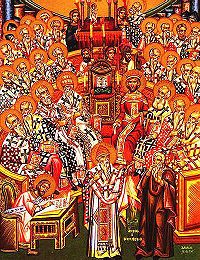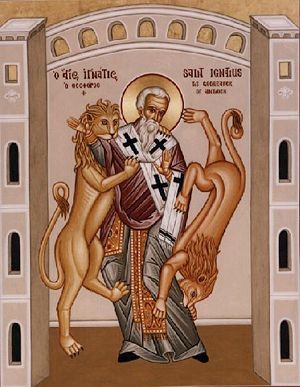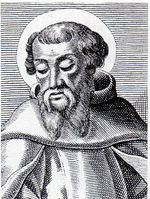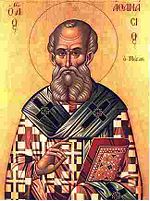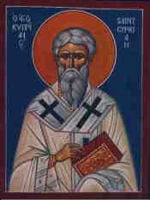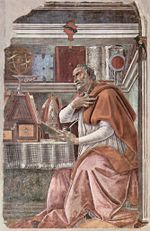Difference between revisions of "Church Fathers" - New World Encyclopedia
m (→Polycarp) |
m (→Latin Fathers) |
||
| Line 77: | Line 77: | ||
''Main article: [[Saint Jerome]]'' | ''Main article: [[Saint Jerome]]'' | ||
Jerome (''c'' 347 – September 30, 420) is best known as the translator of the [[Bible]] from [[Greek language|Greek]] and [[Hebrew language|Hebrew]] into [[Latin]]. He was a also a noted [[Christian apologetics|Christian apologist]]. Jerome's edition of the Bible, the ''[[Vulgate]]'', is still an important text of the [[Catholicism|Roman Catholic Church]]. | Jerome (''c'' 347 – September 30, 420) is best known as the translator of the [[Bible]] from [[Greek language|Greek]] and [[Hebrew language|Hebrew]] into [[Latin]]. He was a also a noted [[Christian apologetics|Christian apologist]]. Jerome's edition of the Bible, the ''[[Vulgate]]'', is still an important text of the [[Catholicism|Roman Catholic Church]]. | ||
| − | + | [[Image:Sandro Botticelli 050.jpg|thumb|150px|Augustine of Hippo]] | |
===Augustine=== | ===Augustine=== | ||
''Main article: [[Augustine of Hippo]]'' | ''Main article: [[Augustine of Hippo]]'' | ||
| Line 84: | Line 84: | ||
===Gregory the Great=== | ===Gregory the Great=== | ||
''Main article: [[Gregory the Great]]'' | ''Main article: [[Gregory the Great]]'' | ||
| − | Pope Gregory I the Great (c. 540 – March 12, 604) reigned as bishop of[[pope]] from September 3, 590 until his death. He was the first of the popes from a [[monastic]] background | + | Pope Gregory I the Great (c. 540 – March 12, 604) reigned as bishop of[[pope]] from September 3, 590 until his death. He was the first of the popes from a [[monastic]] background. Although he was active relative late, he is considered one of the four great [[Latin Fathers]] along with [[Ambrose]], [[Augustine of Hippo|Augustine]], and [[Jerome]]). |
==Other Fathers== | ==Other Fathers== | ||
Revision as of 19:03, 28 May 2008
The Church Fathers or Fathers of the Church are the early and influential theologians and writers in the Christian Church, particularly those of the first five centuries of Christian history. The term is used of writers and teachers of the Church, not necessarily saints. It does not include the New Testament authors, though in the early Church some writing of Church Fathers were considered canonical. It also excludes writers condemned as heretical, although several of the Church Fathers, such as Tertullian and Origen, did occasionally expressed heterodox viewed. Also not included are the Christian apologists such as Justin Martyr and others, who are not churchmen per se, but philosophers who defended Christianity from intellectual criticism.
Apostolic Fathers
The earliest Church Fathers, those of the first two generations after the Apostles of Christ, are usually called the Apostolic Fathers. Famous Apostolic Fathers include Clement of Rome (c 30 - c 100), Ignatius of Antioch, and Polycarp of Smyrna.
Clement of Rome
The epistle known as 1 Clement (c 96) is attributed to this early bishop of Rome. It was copied and widely read in the churches. It is considered the earliest Christian epistle outside the New Testament. Tradition identifies Clement as the fourth pope.
Ignatius of Antioch
Ignatius of Antioch (c 35-110) was the third bishop or Antioch and a student of the Apostle John. En route to his martyrdom in Rome, Ignatius wrote a series of letters to various churches, and these have been preserved as an example of the theology of the earliest Christians. Important topics addressed in these letters include ecclesiology, the sacraments, and the central role of bishops in authorized orthodox teaching.
Polycarp
Polycarp (c 69 - ca. 156) was the bishop of Smyrna (now İzmir in Turkey) who had reportedly been the disciple of the Apostle John. In 155, the Smyrnans demanded Polycarp's execution as a Christian, and he died a martyr. He was also an important figure in the controversy over the date on which Christians celebrate Easter.
Didache
Purporting to be the work of more than one author, the Didache (Koine Greek, meaning "Teaching," is a brief early Christian treatise, traditionally ascribed to the Twelve Apostles. However, it is dated by most scholars to the early second century.[1] It contains instructions for Christian communities and contains passages considered to be the first written catechism, as well as section dealing with rituals such as baptism and eucharist and church organization.
Hermas
The Shepherd of Hermas was a popular second century work considered scriptural by some of the Church fathers, such as Irenaeus and Tertullian. It was written at Rome by the presbyter Hermas, sometimes identified as a brother of Pope Pius I. The work comprises five visions, twelve mandates, and ten parables, calling the faithful to repent of the sins that have harmed it.
Other Apostolic Fathers
Several other writings are also included among the Apostolic Fathers: for example the anti-Jewish letter known as the Epistle of Barnabas, which was often appended to the New Testament; and fragments of the works of Papias. The Epistle of Mathetes to Diognetus and the discourse of Quadratus of Athens are usually counted among the apologists rather than the Church Fathers.
Greek Fathers
Those who wrote in Greek are called the Greek (Church) Fathers. Famous Greek Fathers include Irenaeus of Lyons (whose work has survived only in Latin translation), Clement of Alexandria, the Origen, Athanasius of Alexandria, John Chrysostom, and the Three Cappadocian Fathers.
Irenaeus of Lyons
Irenaeus, (d. near the end of the third century) was bishop of Lugdunum in Gaul, which is now Lyons, France. A a disciple of Polycarp, his best-known book, Against Heresies (c 180), enumerated heresies and attacked them. Irenaeus wrote that the only way for Christians to retain unity was to humbly accept one doctrinal authority—episcopal councils and was the first writer to propose that all four gospels be accepted as canonical. His work is a major source for understanding the heterodox movements of the second century and the orthodox churches' attitude in combating them.
Clement of Alexandria
Clement of Alexandria (Titus Flavius Clemens) (c.150-211/216), was distinguished teacher in the city which became on of early Christianity's most important intellectual centers. He united Greek philosophical traditions with Christian doctrine and thus developed what later became known as Christian Platonism.
Origen
Origen (c 185 - c254) also taught in Alexandria, reviving the catechetical school where Clement had taught. He interpreted scripture allegorically and further developed the tradition of Christian Platonism. Origen taught a doctrine of Universal Salvation in which even demons would eventually be reunited with God. Although some of his views were declared anathema in the 6th century by the Fifth Ecumenical Council[2] Origen's thought exercised significant influence.
Athanasius of Alexandria
Athanasius (c 293-May 2, 373), also known as St. Athanasius the Great, was a theologian, the patriarch ("pope") of Alexandria leader of immense significance in the theological battles of the fourth century. He is best remembered for his role in the conflict with Arianism, although his writings cover a vast array of theological topics of great value to historians.
John Chrysostom
Saint John Chrysostom (c 347– c 407), archbishop of Constantinople, is known for his eloquence in preaching and public speaking, his denunciation of abuse of authority by both ecclesiastical and political leaders, the Liturgy of St. John Chrysostom, his ascetic sensibilities, and his opposition to Judaism. He is particularly honored in the Eastern Orthodox Church.
Cappadocian Fathers
The Cappadocians were three physical brothers who were instrumental in the promotion of early Christian theology and are highly respected in both Western and Eastern churches as saints: Basil the Great, Gregory of Nyssa, and Peter of Sebaste. These scholars, along with their close friend, Gregory of Nazianzus, proved that Christians could hold their own in conversations with learned Greek-speaking intellectuals. They made major contributions to the definition of the Trinity culminating at the First Council of Constantinople in 381, where the final version of the Nicene Creed was formulated.
Latin Fathers
Those fathers who wrote in Latin are called the Latin (Church) Fathers. Famous Latin Fathers include Tertullian, Cyprian of Carthage, Gregory the Great, Augustine of Hippo, Ambrose of Milan, and Jerome.
Tertullian
Main article: Tertullian
Quintus Septimius Florens Tertullianus (c 160 - c 225) was a prolific writer of apologetic, theological, anit-heretical, and ascetic works. He is believed to have introduced the Latin term "trinitas" (Trinity) to the Christian vocabulary and also the formula "three Persons, one Substance"—tres Personae, una Substantia. Later in life, Tertullian joined the Montanists, a heretical sect, but his writings by and large are considered orthodox.
Cyprian
Main article: Cyprian of Carthage Saint Cyprian (died September 14, 258) was bishop of Carthage and an important early Christian writer who eventually died a martyr at Carthage. He is particularly important in defining the Christian church as "Catholic," meaning "universal," as opposed to those who insisted on a more rigorous standard of holiness, especially for church leaders.
Ambrose
Main article: Ambrose of Milan Known in Latin and Low Franconian as Ambrosius (c. 338 – 4 April 397) was a Roman bishop of Milan]] who became one of the most influential ecclesiastical figures of the fourth century. He is counted as one of the four original doctors of the Church and was the teacher of Saint Augustine.
Jerome
Main article: Saint Jerome Jerome (c 347 – September 30, 420) is best known as the translator of the Bible from Greek and Hebrew into Latin. He was a also a noted Christian apologist. Jerome's edition of the Bible, the Vulgate, is still an important text of the Roman Catholic Church.
Augustine
Main article: Augustine of Hippo Augustine (November 13, 354 – August 28, 430), the bishop of Hippo, was both a philosopher and theologian as well as an influential church leader in north Africa. He framed the concepts of original sin and related teachings on divine grace, free will, and the election of the saints, as well as the theory of the just war. His works remain among the most influential in Christian history.
Gregory the Great
Main article: Gregory the Great Pope Gregory I the Great (c. 540 – March 12, 604) reigned as bishop ofpope from September 3, 590 until his death. He was the first of the popes from a monastic background. Although he was active relative late, he is considered one of the four great Latin Fathers along with Ambrose, Augustine, and Jerome).
Other Fathers
The Desert Fathers were early monastics living in the Egyptian desert; although they did not write as much, their influence was also great. Among them are St. Anthony the Great and St. Pachomius. A great number of their usually short sayings is collected in the Apophthegmata Patrum ("Sayings of the Desert Fathers").
The Christian apologists are sometime designated as the Apologetic Fathers. They wrote to justify and defend Christian doctrine against its critics rather than as Christians speaking to other Christians. Among the best know of these are Justin Martyr, Tatian, Athenagoras of Athens, and Hermias.
A small number of Church Fathers wrote in other languages: Saint Ephrem, for example, wrote in Syriac, though his works were widely translated into Latin and Greek.
Later Church Fathers
Although there is no definite rule on the subject, the study of the "early Church" normally ends at the Council of Chalcedon in 451. Those important teachers who come after this are not considered among the "early" Church Fathers. However a number of later writers are also often included among the "The Fathers" Among these Gregory the Great (d. 604) in the West, John of Damascus (d. about 754) in the East. Catholic tradition sometimes counts Bernard of Clairvaux (d. 1153) as the last of the Fathers, and Migne's "Patrologia Latina" extends to Innocent III. Western tradition also sometimes counts Isidore of Seville (d. 636) and the Venerable Bede (d. 735) among the Fathers.
The Eastern Orthodox Church does not consider the age of Church Fathers to be over and includes later influential writers, even up to the present day, in the term. The study of the Church Fathers in the East therefore is a significantly broader one than in the West.
The Church Fathers and Protestantism
Though much Protestant religious thought is based on the principle of Sola Scriptura, the early Protestant reformers, like the Catholic and Orthodox churches, relied heavily on the theological interpretations of scripture set forth by the early Church Fathers. The original Lutheran Augsburg Confession of 1531, for example, begin with the mention of the doctrine professed by the Fathers of the First Council of Nicea. John Calvin's French Confession of Faith of 1559 states, "And we confess that which has been established by the ancient councils, and we detest all sects and heresies which were rejected by the holy doctors, such as St. Hilary, St. Athanasius, St. Ambrose and St. Cyril."[3] The Scots Confession of 1560 deals with general councils in its twentieth chapter.
Likewise, the Thirty-nine Articles of the Church of England, both the original of 1562-1571 and the American version of 1801, explicitly accept the Nicene Creed in article 7. Even when a particular Protestant confessional formula does not mention the Nicene Council or its creed, this doctrine is nearly always asserted. Many Protestant seminaries provide courses on Patristics as part of their curriculum.
Only in the nineteenth century did Protestant theologians begin seriously challenging the ideas of the early Church Fathers by using the historical-critical method of biblical analysis to attempt to separate the teachings of Jesus himself from those of the later church tradition. Writers such as Ritschl and Adolf arnack were among the influential pioneers of this movement.
Patristics
The study of the Church Fathers is known as "Patristics." Works of fathers in early Christianity prior to Nicene Christianity, were translated into English in a nineteenth century collection known as the Ante-Nicene Fathers. Those of period of the First Council of Nicaea (325 C.E.) and continuing through the Second Council of Nicea (787) are collected in Nicene and Post-Nicene Fathers.
ReferencesISBN links support NWE through referral fees
- ↑ Bruce Metzger Metzger, Bruce. The canon of the New Testament. 1997
- ↑ The Anathematisms of the Emperor Justinian Against Origen (Schaff, op. cit.)
- ↑ Henry Beveridge, trans. Calvin's Tracts (Calvin Translation Socieity, Edinburgh. 1849)
See also
- Doctors of the Church
- List of Church Fathers
Defined as an early writer of Christian doctrine; a Christian writer of the pre-8th century group of scholars who established the doctrines and practices of Christianity in their work (usually used in the plural).
External links
- Chart of Church Fathers at ReligionFacts.com
- Church Fathers' works in English edited by Philip Schaff, at the Christian Classics Ethereal Library
- Church Fathers at Newadvent.org
- Church Fathers at the Patristics In English Project Site
- Early Church Fathers Addtional Texts Part of the Tertullian corpus.
- Excerpts from Defensor Grammaticus
- Excerpts from the Church Fathers
- The Fathers, the Scholastics, and Ourselves by von Balthasar
- Faulkner University Patristics Project A growing collection of English translations of patristic texts and high-resolution scans from the comprehensive Patrologia compiled by J. P. Migne.
- Primer on the Church Fathers at Corunum
- Writtings from the church fathers at www.goarch.com.
- The Fathers of the Church: A New Translation, by Ludwig Schopp, founder and editorial director. Works hosted at the Internet Archive
- Migne Patrologia Latina and Graeca: a free digital edition of almost all the original texts.
| ||||||||||||||||||||||||||||
Credits
New World Encyclopedia writers and editors rewrote and completed the Wikipedia article in accordance with New World Encyclopedia standards. This article abides by terms of the Creative Commons CC-by-sa 3.0 License (CC-by-sa), which may be used and disseminated with proper attribution. Credit is due under the terms of this license that can reference both the New World Encyclopedia contributors and the selfless volunteer contributors of the Wikimedia Foundation. To cite this article click here for a list of acceptable citing formats.The history of earlier contributions by wikipedians is accessible to researchers here:
The history of this article since it was imported to New World Encyclopedia:
Note: Some restrictions may apply to use of individual images which are separately licensed.
